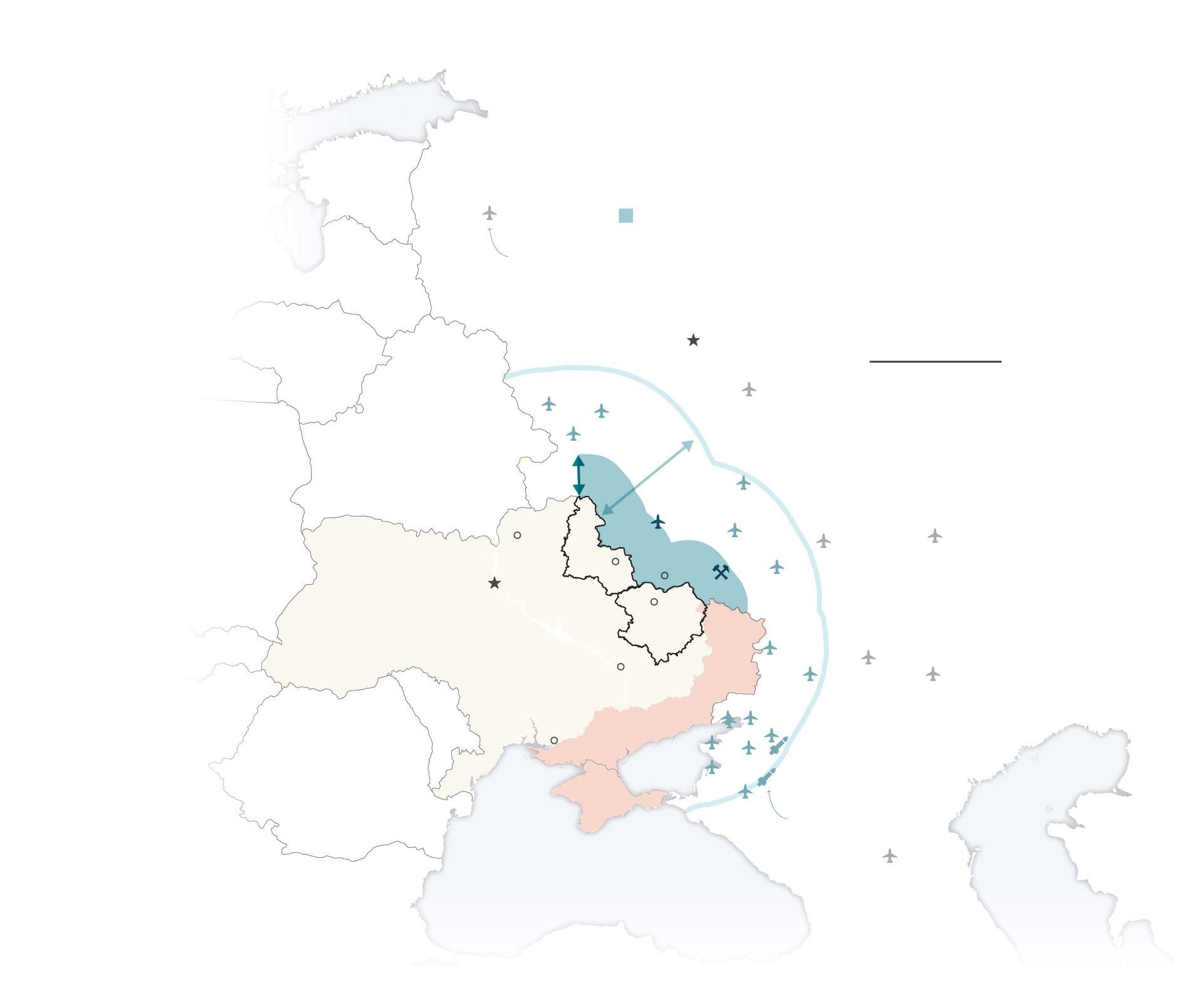Approximate permitted target range
of U.S. arms within Russia
Alexeyevka
(under construction)
Illegally annexed by
Russia in 2014
LARIS KARKLIS AND SAMUEL GRANADOS / THE WASHINGTON POST

Approximate permitted target range
of U.S. arms within Russia
Alexeyevka
(under construction)
Illegally annexed by
Russia in 2014
LARIS KARKLIS AND SAMUEL GRANADOS / THE WASHINGTON POST

Approximate permitted target range
of U.S. arms within Russia
Alexeyevka
(under construction)
Illegally annexed by
Russia in 2014
LARIS KARKLIS AND SAMUEL GRANADOS / THE WASHINGTON POST

Approximate permitted target range
of U.S. arms within Russia
Alexeyevka
(under construction)
Illegally annexed by
Russia in 2014
LARIS KARKLIS AND SAMUEL GRANADOS / THE WASHINGTON POST
The Ukrainian officials said the United States has restricted Ukraine to firing less than 100 kilometers, or about 62 miles, from the border. Both spoke on the condition of anonymity because they were not authorized to speak publicly about the rule. U.S. officials declined to specify the limitation but said the Ukrainians’ assertion of less than 100 kilometers was incorrect.
“The U.S. has agreed to allow Ukraine to fire U.S.-provided weapons into Russia across where Russian forces are coming to attempt to take Ukrainian territory,” said a Pentagon spokesman, Maj. Charlie Dietz. “This is not about geography or a certain radius, but if Russia is attacking or about to attack from its territory into Ukraine, Ukraine has the ability to hit back against the forces that are hitting it from across the border.”
Ukraine is also permitted to use U.S.-supplied air defense systems to strike Russian planes “if they’re about to fire into Ukrainian airspace,” Dietz said.
National security adviser Jake Sullivan emphasized the point in an interview on PBS, saying: “This is not about geography. It’s about common sense. If Russia is attacking or about to attack from its territory into Ukraine, it only makes sense to allow Ukraine to hit back against the forces that are hitting it from across the border.”
While officials in Kyiv do not want to be seen as publicly contradicting their American counterparts, it is clear that the Ukrainian military does not believe it has as much latitude as the statements from White House and Pentagon officials seem to suggest.
And the results of Ukrainian strikes in the three weeks since Washington approved Ukraine’s request to use certain Western weapons to hit Russian territory corroborate the Ukrainian description of a significantly restrictive range.
The Institute for the Study of War (ISW), a Washington-based think tank, reported this month that the U.S. policy limiting Ukraine’s usage of American weapons in Russia had effectively created “a vast sanctuary … which Russia exploits to shield its combat forces, command and control, logistics, and rear area support services that the Russian military uses to conduct its military operations in Ukraine.”
One Ukrainian defense official said that permission to use U.S. weapons to strike inside Russia “has definitely changed things. The enemy has certainly felt it, especially directly on the front line.”
But the official added, “Neither the range nor the category [of weapons] is sufficient.”
In its report, the ISW said the easing of U.S. restrictions in areas close to Kharkiv had reduced Russia’s “ground sanctuary” — the area still out of Ukraine’s reach with U.S. arms — by merely 15 percent, essentially preserving Russia’s military advantage against Ukraine.
Only “a small area along the Russian-Ukrainian international border” in Russia was permitted for targeting, the ISW said.
In a war of attrition that has seen huge loss of civilian life, the ISW said much more could be done to reduce Russia’s advantage. “The U.S. policy change, while a step in the right direction, is by itself inadequate and unable to disrupt Russian operations at scale,” it said.
Since the shift in U.S. policy, Kharkiv, Ukraine’s second-largest city, has experienced much-needed respite after months of relentless attacks by Russian missiles, local officials said.
Footage in early June from Russia’s Belgorod region just across the border appeared to show a Ukrainian strike using a U.S.-provided HIMARS rocket system on a Russian S-300/400 system, the ISW reported.
Striking the S-300 and S-400 launching points reduced missile attacks on Kharkiv city from 25 in May to zero so far this month, said Kharkiv Mayor Ihor Terekhov.
“The situation massively changed” in the city — which sits just 19 miles from the Russian border — once the U.S. restrictions were lifted, Terekhov said.
Still, the mayor said his city remains “under the constant threat” from glide bombs — modified Soviet-era weapons that Russia drops from airplanes.

Russia’s bombing of Kharkiv
474 hours and 55 minutes of air alerts (roughly 20 full days of active sirens)
62 hours
of air alerts
(roughly 2.5 days)
76 strikes on the city
(37 glide bombs, 25 S300/S400 missiles, 15 Lancet or Shahed drones)
3 strikes on the city
(6 glide bombs, no S-300/400 strikes)
Source: Kharkiv mayor’s office

Russia’s bombing of Kharkiv
474 hours and 55 minutes of air alerts (roughly 20 full days of active sirens)
62 hours
of air alerts
(roughly 2.5 days)
76 strikes on the city
(37 glide bombs, 25 S300/S400 missiles, 15 Lancet or Shahed drones)
3 strikes on the city
(6 glide bombs, no S-300/400 strikes)
Source: Kharkiv mayor’s office

Russia’s bombing of Kharkiv
474 hours and 55 minutes of air alerts (roughly 20 full days of active sirens)
62 hours
of air alerts
(roughly 2.5 days)
76 strikes on the city
(37 glide bombs, 25 S300/S400 missiles, 15 Lancet or Shahed drones)
3 strikes on the city
(6 glide bombs, no S-300/400 strikes)
Source: Kharkiv mayor’s office

Russia’s bombing of Kharkiv
474 hours and 55 minutes of air alerts (roughly 20 full days of active sirens)
62 hours
of air alerts
(roughly 2.5 days)
76 strikes on the city
(37 glide bombs, 25 S300/S400 missiles, 15 Lancet or Shahed drones)
3 strikes on the city
(6 glide bombs, no S-300/400 strikes)
Source: Kharkiv mayor’s office
The bombs can weigh thousands of pounds and are equipped with guidance systems. They are typically dropped from more than 15 miles behind the Russian border, but the planes take off from bases farther away, beyond the U.S.-approved strike range.
Russia fired more than 3,200 such bombs at Ukraine in May alone, President Volodymyr Zelensky said last month. Ukrainian air defense systems struggle to intercept the bombs.
This month, Russia fired six glide bombs on Kharkiv city, killing one person and injuring seven, Terekhov said. Many more have targeted military positions.
Ukraine is waiting for its first batch of U.S.-made F-16 fighter jets, which could help deter Russia from dropping so many of the bombs. Ukraine is also developing its own such bombs to drop on Russian positions, although it’s unclear how effective they may be.
Right now, however, officials say Ukraine’s inability to deter Russian glide bomb attacks is the main shortcoming in the otherwise effective U.S. policy change.
The change “helped to reduce terror strikes against Kharkiv,” another Ukrainian official said. “That’s why we say that [a] longer distance for us will help to reduce much more … Putin’s ability to continue this war.”
For more than two years, the Biden administration refused to let Ukraine use U.S.-provided weapons to hit targets inside Russia, citing fears of a direct conflict between the United States and Russia. Instead, Ukraine was limited to using the U.S. weapons on targets in Russian-occupied Ukraine.
The rules changed last month after Russia unleashed a new invasion across the border into the Kharkiv region, displacing thousands and stirring fears of an advance on Kharkiv city.
Both sides sustained major losses. Ukraine managed to prevent the Russian forces from taking significant territory, but battles continue in the border regions.
Even under the new rules, however, President Biden has refused to greenlight the use of long-range U.S. weapons, such as the Army Tactical Missile System, or ATACMS, leaving Ukraine to continue to rely on its own homemade drones for strikes deeper inside Russia.
Last month, Kharkiv experienced attacks that killed 39 people and injured 239 in what Terekhov called “a terrifying disaster.” Washington announced the policy change on May 30 and, within days, Kharkiv city saw a sharp reduction in air alarms and Russian attacks.
Despite the relative improvement, Kharkiv city urgently needs improved air defenses to protect civilians from the glide bomb attacks, Terekhov said.
“For us now this question is a matter of life,” he said. “If we will have the most modern air defense systems and if we will have the modern planes, then they will be scared to use these planes because they can be struck down and they will not be able to approach close to the border.”

New air base being built near Alexeyevka
Source: Copernicus Sentinel

New air base being built near Alexeyevka
Source: Copernicus Sentinel

New air base being built near Alexeyevka
Source: Copernicus Sentinel

New air base being built near Alexeyevka
Source: Copernicus Sentinel
Air bases close to the border give Russia a major advantage, and in April an open-source researcher with the handle RedIntelPanda posted satellite images on X showing the construction of a new base in southern Russia with a runway estimated to be 5,900 feet long.
The airfield is close to a military logistics hub near Alexeyevka, a town in Belgorod region, about 45 miles from Ukraine border.
Military officials acknowledged that the policy change made a dramatic difference for life in Kharkiv but said it has not protected Ukrainian military positions from regular assault by glide bombs.
Maj. Nadiia Zamryha, press officer of the 14th Brigade, said troops fighting near Kupyansk in the northeast of the Kharkiv region continue to come under regular attack from antiaircraft missiles, glide bombs and unguided rockets.
Biden’s change allowed Ukraine to target “areas where equipment is concentrated and locations from where missile strikes are launched on the territory of Ukraine; not a single S-300 missile has hit Kharkiv. This is a fact,” said Denys Yaroslavsky, commander of a reconnaissance battalion in Ukraine’s 57th Brigade. “At the same time, this has not significantly changed the situation directly on the front line.”
“The city of Vovchansk,” he added, “continues to be destroyed by aerial bombs, artillery and everything else they have.”
Alex Horton in Washington contributed to this report.



